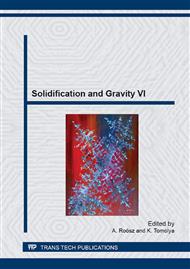[1]
hereafter referred to as MHN model. The latest variant of MHN model is the one reported in [6], which has taken into account both recalescence stifling nucleation and solute segregation stifling nucleation mechanisms encountered in various solidification experiments of multi-component alloys. Cellular Automaton Finite Element (CAFE), originally proposed by Gandin and Rappaz in [] Ch. -A. Gandin, M. Rappaz, A 3D cellular automaton algorithm for the prediction of dendritic grain growth, Acta Mater. 45 (1997).
DOI: 10.1016/s1359-6454(96)00303-5
Google Scholar
158 Molar volume of liquid and solid phase (m3).
Google Scholar
[1]
0×105 Entropy of fusion, ∆SV, (J K-1 m-3).
Google Scholar
[1]
11×106 Latent heat per unit volume, (J/m3).
Google Scholar
[9]
5×108 Heat capacity of melt (J K-1 m-3).
Google Scholar
[2]
58×106 Grain refiner addition level 1 Part Per Thousand (PPT) by weight Diffusivity Taken from [16] Diffusion constant (m2/s) activation energy (kJ/mole) Evaluated at 650 °C Cu.
Google Scholar
[2]
84×10-9 Linear binary phase diagram data, taken from [1, 6] except for Zn, which is taken from commercial CALPHAD thermodynamic database TTAL7 Liquidus slope (K/wt%) Partition coefficient Cu -3. 4.
Google Scholar
41 Ternary Al-Fe-Mg phase diagram data calculated from commercial CALPHAD thermodynamic database TTAL7 The observed grain size differences in Fig. 1(a) are believed to be attributed to the differences in instantaneous Q values. Fig. 1(b) shows the calculated evolutions of instantaneous Q value with undercooling for the three alloy systems. With the increase of undercooling, the Q value, initially equal to 1. 0, decreases sharply in the Al-Ti alloy, but increases slightly in the Al-Fe and Al-Mg alloys. The second group simulation is to test our speculation that grain size has a ubiquitous relation with the averaged diffusivity-weighted Q, W, as defined by Eq. 5. Simulations were conducted for a series of Al-Fe-Mg alloys. The effective cooling rate was 0. 5 K/s and the addition level of grain refiners was 1 PPT. Before presenting the simulation results, Q, U and W factors are extended to multi-component alloys as listed below: Qmulti=i=1nmiki-1ciL (Eq. 10a) Umulti=i=1nmiki-1ciLDrefDi (Eq. 10b) Wmulti= i=1nmiki-1ciLDrefDi+∆T2i=1nDrefDimiCi0ki-1Di(1-ki)i=1nmiCi0ki-1Di (Eq. 10c) The second term in the right hand side of Eq. 10c represents the extra contribution of partition coefficient to growth restriction due to the averaging procedure. (a) (b) (c) Fig. 2 The predicted relations between grain size and 1/Q (a), 1/U (b) and 1/W (c) for the Al-Fe-Mg alloys solidified with the effective cooling rate of 0. 5 °C/s in isothermal melt and grain refiner addition level of 1 PPT. The phase diagram data used in the simulations are from CALPHAD software Thermo-Calc with TTAL7 database and the diffusivities of the solutes are taken from Table 1. Fig. 2a shows predicted grain size and 1/Q relations. All the calculated grain sizes are scattered within the region banded by Al-Fe and Al-Mg binary alloys, which are treated as ternary alloys with the zero addition of the second alloying component. The scatter is reduced in Fig. 2b where grain size has been plotted against 1/U. No scatter is seen in Fig. 2C where grain size and 1/R relation is shown. Fig. 2 has clearly demonstrated that there is no universal relation between grain size and the initial Q for multicomponent alloys, and a clear relation exists with W, the diffusivity-weighted average Q. (a) (b) Fig. 3 The grain sizes measured by Spittle et al are plotted with 1/Q (a) and 1/R (b) for binary Al-Cu, Al-Zn, Al-Si and Al-Mg alloys inoculated with 2 PPT Al-Ti-B grain refiners. Q and R values were re-calculated from the reported alloy compositions and the Ti content (estimated to be 0. 0056wt%) with the linear phase diagram parameters and diffusivities listed in Table 1. Fig. 3 shows the measured experimental grain size of Al-X alloys inoculated with 2 PPT Al-5Ti-B grain refiners by Spittle and Sadli, as a function of 1/Q and 1/W, where X is one of the Cu, Mg, Si and Zn elements[] J.A. Spittle, S. Sadli, Effect of alloy variables on grain refinement of binary aluminium alloys with Al-Ti-B, Materials Science and Technology 11 (1995).
Google Scholar


